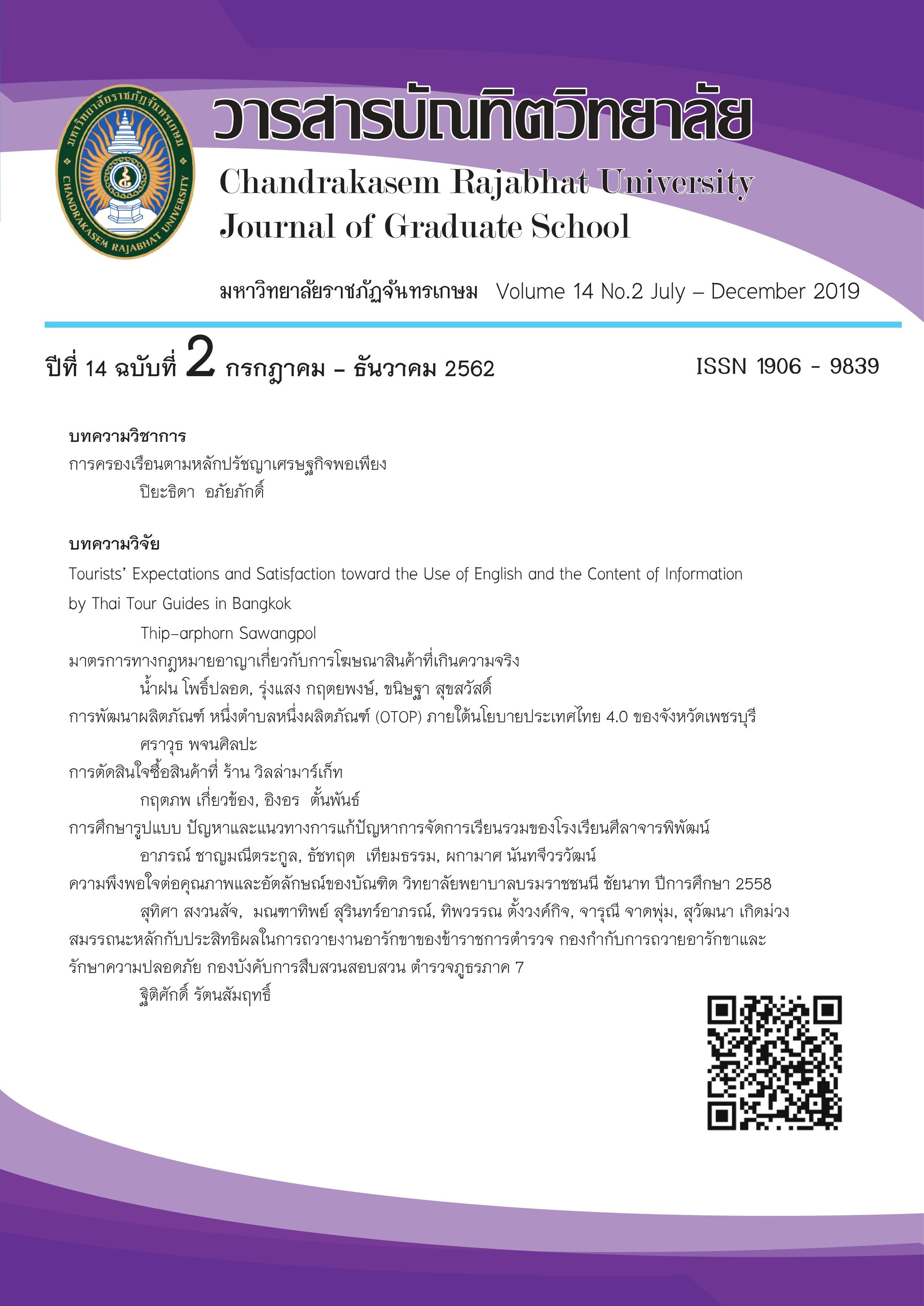การพัฒนาผลิตภัณฑ์ หนึ่งตำบลหนึ่งผลิตภัณฑ์ (OTOP) ภายใต้นโยบายประเทศไทย 4.0 ของจังหวัดเพชรบุรี
Main Article Content
บทคัดย่อ
การวิจัยครั้งนี้มีวัตถุประสงค์เพื่อ (1) ศึกษาระดับการพัฒนาผลิตภัณฑ์ หนึ่งตำบลหนึ่งผลิตภัณฑ์ (OTOP) ภายใต้นโยบายประเทศไทย 4.0 ของจังหวัดเพชรบุรี (2) ศึกษาปัจจัยในการพัฒนาผลิตภัณฑ์ หนึ่งตำบลหนึ่งผลิตภัณฑ์ (OTOP) ภายใต้นโยบายประเทศไทย 4.0 ของจังหวัดเพชรบุรี (3) ศึกษาปัจจัยในการพัฒนาผลิตภัณฑ์มีความสัมพันธ์เชิง เหตุ-ผลกับการพัฒนาผลิตภัณฑ์ หนึ่งตำบลหนึ่งผลิตภัณฑ์ (OTOP) ภายใต้นโยบายประเทศไทย 4.0 ของจังหวัดเพชรบุรี กลุ่มตัวอย่างที่ใช้ในการวิจัย ได้แก่ ผู้ประกอบการผลิตภัณฑ์หนึ่งตำบลหนึ่งผลิตภัณฑ์ (OTOP) ที่ได้รับรองการลงทะเบียนเป็นผู้ผลิต ผู้ประกอบการ OTOP ปี 2560 จากทั้งหมด 8 อำเภอ จำนวน 122 คน วิเคราะห์ข้อมูลโดยใช้ค่าสถิติเชิงพรรณนา ได้แก่ ค่าร้อยละ ค่าเฉลี่ย ค่าเบี่ยงเบนมาตรฐาน และสถิติเชิงอนุมาน โดยใช้สถิติค่าไคสแควร์ และการวิเคราะห์การถดถอยพหุคูณ
ผลการศึกษาพบว่า (1) ผู้ตอบแบบสอบถามส่วนใหญ่เป็นเพศหญิง มีอายุ 41 - 50 ปี มีสถานภาพสมรส จบการศึกษาระดับมัธยมศึกษาตอนปลาย / ปวช. และมีรายได้เฉลี่ยต่อเดือน มากกว่า 25,000 บาท (2) การพัฒนาผลิตภัณฑ์ หนึ่งตำบลหนึ่งผลิตภัณฑ์ (OTOP) ภายใต้นโยบายประเทศไทย 4.0 ของจังหวัดเพชรบุรี ในภาพรวมมีการพัฒนาอยู่ในระดับมาก เรียงตามลำดับ ดังนี้ การพัฒนาผลิตภัณฑ์ OTOP ใหม่ การพัฒนามาตรฐานผลิตภัณฑ์ การพัฒนาบรรจุภัณฑ์ และการพัฒนาการแปรรูปผลิตภัณฑ์ (3) ปัจจัยในการพัฒนาผลิตภัณฑ์ หนึ่งตำบลหนึ่งผลิตภัณฑ์ (OTOP) ภายใต้นโยบายประเทศไทย 4.0 ของจังหวัดเพชรบุรี พบว่า ในภาพรวมมีการปฏิบัติในระดับมาก เรียงตามลำดับดังนี้ เทคโนโลยี ความคิดสร้างสรรค์ การสนับสนุนของภาครัฐ และนวัตกรรม และพบว่า ปัจจัยในการพัฒนาผลิตภัณฑ์มีความสัมพันธ์เชิงเหตุ – ผลกับการพัฒนาผลิตภัณฑ์ หนึ่งตำบลหนึ่งผลิตภัณฑ์ (OTOP) ภายใต้นโยบายประเทศไทย 4.0 ของจังหวัดเพชรบุรี พิจารณารายด้านพบว่า ปัจจัยในการพัฒนาผลิตภัณฑ์ ด้านนวัตกรรม ด้านเทคโนโลยี ด้านความคิดสร้างสรรค์ ด้านการสนับสนุนของภาครัฐ มีความสัมพันธ์เชิงเหตุ – ผลกับการพัฒนาผลิตภัณฑ์ หนึ่งตำบลหนึ่งผลิตภัณฑ์ (OTOP) ภายใต้นโยบายประเทศไทย 4.0 ของจังหวัดเพชรบุรี อย่างมีนัยสำคัญทางสถิติที่ระดับ 0.001 (4) ลักษณะส่วนบุคคลในภาพรวมไม่มีความสัมพันธ์กับการพัฒนาผลิตภัณฑ์ หนึ่งตำบลหนึ่งผลิตภัณฑ์ (OTOP) ภายใต้นโยบายประเทศไทย 4.0 ของจังหวัดเพชรบุรี แต่เมื่อพิจารณารายด้าน พบว่า อายุ
มีความสัมพันธ์กับการพัฒนาผลิตภัณฑ์ หนึ่งตำบลหนึ่งผลิตภัณฑ์ (OTOP) ภายใต้นโยบายประเทศไทย 4.0 ของจังหวัดเพชรบุรี ด้านการพัฒนาผลิตภัณฑ์ OTOP ใหม่ อย่างมีนัยสำคัญทางสถิติที่ระดับ 0.05 และระดับการศึกษามีความสัมพันธ์กับการพัฒนาผลิตภัณฑ์ หนึ่งตำบลหนึ่งผลิตภัณฑ์ (OTOP) ภายใต้นโยบายประเทศไทย 4.0 ของจังหวัดเพชรบุรี ด้านการพัฒนาการแปรรูปผลิตภัณฑ์ อย่างมีนัยสำคัญทางสถิติที่ระดับ 0.05
Article Details
เอกสารอ้างอิง
กระทรวงมหาดไทย. (2560). ส่วนพัฒนายุทธศาสตร์สำนักนโยบายและยุทธศาสตร์. กรุงเทพฯ: กระทรวงมหาดไทย.
คม ชัด ลึก. ข่าวเศรษฐกิจ.(2560). พช. สนองนโยบายโอทอปสร้างชาติ. สืบค้นเมื่อ 15 ตุลาคม 2560 เข้าถึงได้จาก https://www.komchadluek.net/news/economic/265231
ธันยมัย เจียรกุล. (2557). ปัญหาและแนวทางการปรับตัวของ OTOP. วารสารนักบริหาร Executive Journal, 34(1), 177-191
นพวรรณ ชิวอารี. (2555). การวิจัยและพัฒนาบรรจุภัณฑ์หมูแปรรูปเพื่อส่งเสริมการขาย กรณีศึกษาบรรจุภัณฑ์หมูแปรรูปในชุมชนท้องถิ่นจังหวัดนครปฐม (วิทยานิพนธ์ปริญญามหาบัณฑิต). กรุงเทพฯ : มหาวิทยาลัยศรีนครินทรวิโรฒ.
พรพิมล สัมพัทธ์พงศ์. (2555). พฤติกรรมการตัดสินใจของผู้บริโภคและส่วนประสมทางการตลาดของสินค้าหนึ่งตำบลหนึ่งผลิตภัณฑ์ระดับ 5 ดาวในจังหวัดนนทบุรี (วิทยานิพนธ์ปริญญามหาบัณฑิต). กรุงเทพฯ : วิทยาลัยราชพฤกษ์.
พิชัย เหลี่ยวเรืองรัตน์ (2550). “การพัฒนากระบวนการผลิตและบรรจุภัณฑ์ผลิตภัณฑ์ข้าวกล้องของผู้ประกอบการในชุมชนเพื่อสืบสานภูมิปัญญาท้องถิ่นอยางยั่งยืน (รายงานวิจัย). เชียงใหม่ : มหาวิทยาลัยฟาร์อีสเทอร์น.
รัตติกาล ก้อนแปง. (2556). การพัฒนาผลการเรียนรู้ ความคิดสร้างสรรค์ และความเข้าใจคงทนของนักศึกษา ปวช.3/4 แผนกวิชาการท่องเที่ยว ด้วยการจัดการเรียนรู้แบบซินเนคติคส์ (Synetics Instruction Model) ในรายวิชาการโรงแรมภายหลังจากการจัดการเรียนรู้ด้วยวิธีการซินเนคติคส์. (วิทยานิพนธ์ปริญญามหาบัณฑิต). เชียงใหม่ : สถาบันราชภัฏเชียงใหม่.
ล้วน สายยศ และอังคณา สายยศ. (2538). เทคนิคการวิจัยทางการศึกษา. พิมพ์ครั้งที่ 4. กรุงเทพฯ: สุวีริยาสาส์น.
ศรินทร์ ขันติวัฒนะกุล. (2558). ปัญหาและแนวทางการพัฒนาการตลาดของกลุ่มอาชีพในเขตจตุจักรเพื่อการพัฒนาธุรกิจย่างยั่งยืน (วิทยานิพนธ์ปริญญามหาบัณฑิต). กรุงเทพฯ : มหาวิทยาลัยราชภัฏจันทรเกษม.
สัมฤทธิ์ จำนงค์. (2557). ภาพลักษณ์องค์กรและนวัตกรรมที่ส่งผลต่อความภักดีของผู้ใช้บริการไปรษณีย์ด่วนพิเศษในประเทศในเขตกรุงเทพมหานคร (วิทยานิพนธ์ปริญญามหาบัณฑิต). กรุงเทพฯ : มหาวิทยาลัยกรุงเทพ.
Davis, G. A. (1973). The school wide enrichment model: Developing creative andproductive giftedness. In Canlangelo, N., and Davis, G. A. Handbook of GiftedEducation 184-203. United State of American: Pearson Education.
Greenl,G.B. (1991). How Many Subjects Dose It Take to Do a Regression Analysis? Multivariate Behavioral Research, 26(3), 109-110. Retive March 18, 2018 From https://research.kbu.ac.th/home/journal/pdf/journal_v15_no1.pdf
Layton. (1994). Research in education. (4th ed.). New Jersey: Prentice Hall.
Schumpeter J. (1934). The Theory of Economic. New York Cambridge : Harvard University Press


